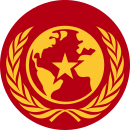Mais idiomas
Mais ações
Holodomor é a tese que afirma que o governo soviético matou, de fome, ucranianos durante a fome soviética de 1931–1932. É uma propaganda divulgada historicamente por fascistas contra a União Soviética a fim de diminuir seu apoio internacional[1]. Atualmente, essa propaganda ainda circula principalmente pela mídia ocidental[2] e por ucranianos que sofreram da fome.[3]
A primeira vez que a alegação de um genocídio feito pelos soviéticos apareceu foi no jornal nazista Völkischer Beobachter[4], em 18 de agosto de 1933. A matéria foi reproduzida também no tabloide britânico London Daily Express[5], mas foi divulgada - e repercutida - principalmente nos Estados Unidos, aparecendo pela primeira vez em 18 de fevereiro de 1935 nos jornais Chicago American e New York Evening Journal, cujos donos era William Rudolph Hearst[6], fundador da imprensa amarela. Não havia mais fome na URSS durante a publicação desses artigos. Assim, os jornais, para ilustrar suas matérias, utilizaram fotos de outras passadas fomes na União Soviética causadas pela Guerra Civil Russa.[7]
Alegações ocidentais sobre a fome
Historiadores burgueses e eurocêntricos normalmente focam nestas categorias para "racionalizar" seu consenso liberal sobre a fome:
A liderança soviética causou a fome intencionalmente
Veículos de mídia como a Encyclopedia Britannica, o filme "Colheita Amarga" e historiadores burgueses afirmam que a liderança soviética causou deliberadamente a fome. Entretanto, há evidências históricas na União Soviética que relatam que Stalin não estava ciente da fome quando a mesma aconteceu.[8]
Nacionalismo ucraniano
Historiadores burgueses também afirmam que Stalin tinha como alvo o povo ucraniano, a fim de eliminar o nacionalismo ucraniano. Os ucranianos, em sua maioria, se consideravam russos e não reivindicaram independência. A região com mais nacionalistas ucranianos era na parte Oeste do país, que na época era de domínio polonês.
Referências
- ↑ Douglas Tottle (1987). Fraud, famine and fascism: the Ukrainian genocide myth from Hitler to Harvard.
- ↑ https://www.britannica.com/event/Holodomor
- ↑ https://holodomormuseum.org.ua/en/holodomor-remembrance-day/
- ↑ “Featured in the Nazi press in 1933, the famine-genocide campaign
moved to Britain in 1934, and to the United States the year after. In
Germany, a country with a history of strong communist, socialist and trade
union movements, the Nazis created the first organized propaganda
campaign (1933-1935) as part of their consolidation of power. In Britain
and the United States, on the other hand, the campaign was advanced as
part of right-wing efforts to keep the Soviet Union isolated and out of the
League of Nations. It also served to discourage growing working class
militancy in the Great Depression”
Douglas Tottle (1987). Fraud, famine and fascism: : the Ukrainian genocide myth from Hitler to Harvard (p. 2). Progress Books. - ↑ “Portions of the 1935 Hearst-Walker series, including some of the photos, had in fact appeared the year previous in the August 6, 1934 London Daily Express. Attributed to an anonymous young English "tourist,” the story includes a virtually identical account of Walker’s "frog child” fabrication. However, this earlier version of the hoax locates the tale in Belgorod — which is in Russia proper. Subsequent versions of the hoax over the decades politically relocate the story to Kharkov, which is of course in Ukraine.”
Douglas Tottle (1987). Fraud, famine and fascism: the Ukrainian genocide myth from Hitler to Harvard (p. 11). Progress Books. - ↑ “In the fall of 1934, an American using the name Thomas Walker entered the Soviet Union. After tarrying less than a week in Moscow, he spent the remainder of his thirteen-day journey in transit to the Manchurian border, at which point he left the USSR never to return. This seemingly uneventful journey was the pretext for one of the greatest frauds ever perpetrated in the history of 20th century journalism.”
Douglas Tottle (1987). Fraud, famine and fascism: the Ukrainian genocide myth from Hitler to Harvard (p. 5). [PDF] Progress Books. - ↑ “Dr. Ditloff [...] was Director of the German government’s agricultural concession in the North Caucasus under an agreement between the German government and the Soviets. When Hitler took power in early 1933, Ditloff [...] did not resign in protest. He remained as Director for the project’s duration, indicating that the Nazis did not consider him inimical to their interests. Following his return to Nazi Germany later that year, Ditloff gathered or fronted for a spurious assortment of famine photographs. These, as has been shown, included photos stolen from 1921-1922 famine sources. In addition, at least 25 of the Ditloff photos can be shown to have been released by the Nazis, many of which were passed to or picked up by various anti-Soviet and pro-fascist publishers abroad.”
Douglas Tottle (1987). Fraud, famine and fascism: the Ukrainian genocide myth from Hitler to Harvard (p. 34). [PDF] Progress Books. - ↑ Fighting the “Holodomor” Myth: Archival Evidence that Stalin was Unaware of Conditions in the Ukraine and Tried to Relieve the Situation When He was Informed. - StalinSociety.org (Arquivado).
